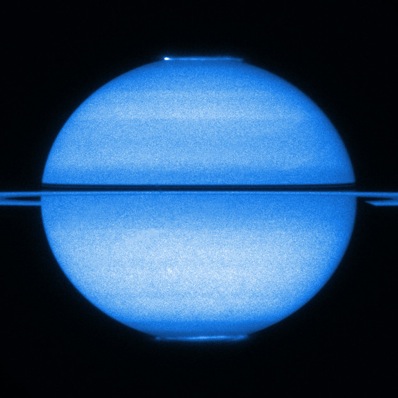



|

|

Unique images reveal Saturn's dynamic aurorae
DR EMILY BALDWIN
ASTRONOMY NOW
Posted: 11 February 2010


Taking advantage of Saturn's edge-on ring orientation, astronomers have created a unique movie featuring aurorae at both poles that reveal subtleties between the northern and southern auroral regions.
Hubble recorded activity at Saturn in January and March 2009. As well as the double aurora, watch out for some of Saturn's moons passing across the face of their parent planet. Credit: NASA, ESA, and Jonathan Nichols (University of Leicester).
Taking nearly 30 years to complete one orbit around the Sun, Saturn only offers this edge-on configuration once every 15 years. In 2009 Saturn also reached equinox, when both poles are equally illuminated by sunlight. This afforded a team of scientists led by Jonathan Nichols at the University of Leicester to simultaneously study the aurorae at both poles of the giant planet using the Hubble Space Telescope.
"Hubble has proved to be one of mankind’s most important scientific tools, and this is the first time that a group in the UK has led a HST program to observe the aurorae on another world," says Nichols. Aurorae are formed when electrically charged solar wind particles become trapped in a planet's magnetic fields. The magnetic field focuses the particles at the polar regions where they interact with atoms in the upper layers of the atmosphere. On Earth, spectacular green and red colours are usually seen as a result of nitrogen and oxygen emissions.
 This unique view of Saturn shows the giant planet with its rings edge-on and both poles in view. Image: NASA, ESA, and Jonathan Nichols (University of Leicester). This unique view of Saturn shows the giant planet with its rings edge-on and both poles in view. Image: NASA, ESA, and Jonathan Nichols (University of Leicester).
The new images of Saturn's swirling aurorae will likely be the last that Hubble will capture. "It is particularly exciting to know that these images are unique to science," says Nichols. "They have not, and will never again, be obtained using Hubble. This is because HST pictured Saturn at a very special vantage point, near its equatorial plane. Due to Saturn’s long orbit, HST will not see this view again in its lifetime. This sustained series images of simultaneous north-south aurora are important scientifically, since they cannot be obtained at any other planet, including Earth. They tell us a great deal about the nature of the planet’s magnetic field and the processes which generate aurorae in a way not possible at Earth. It’s a great example of how planetary science can fully complement the study of the Earth."
Initially, Saturn's auroral display appears symmetric at the two poles, a natural consequence of the shape of the planet’s magnetic field creating a series of 'traffic lanes' between the two poles along which the electrically charged particles are confined and rhythmically travel back and forth, but the new images reveal some subtle differences. The auroral oval at the north pole is slightly smaller but more intense than the southern oval, which implies that Saturn’s magnetic field is stronger in the north, accelerating charged particles to higher energies there. This confirms a previous result obtained by the Cassini spacecraft, which has been studying the Saturn system since 2004.
|

|

|

|
|



